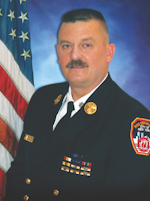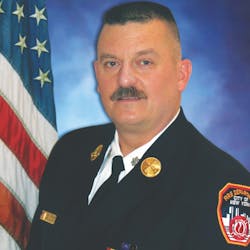So, you walk into the firehouse for a 24-hour shift or for your weekly training night. You’re greeted by the other firefighters who are in your company. Most of them are somewhere out on the apparatus floor looking at equipment as you enter. What is this that they are doing? They’re “getting ready.”
Getting ready is the routine that you should follow every time that you enter the firehouse for a shift or a drill. It includes much more than dropping your gear next to the rig at your riding position.
Turnout gear
The first thing that I always did was to take a look at my turnout gear. It usually was hanging on the rack where I left it the last time that I used it, but, occasionally, it might have been moved or borrowed in my absence.
When you give your turnout gear the once over, look for damage or wear or other problems that you might not have noticed when you last wore it. Also make sure that your gloves, hood and suspenders are in order.
I always reached into my boots all of the way down to the toe to make sure that nothing accidentally dropped into the boots that would prevent me from quickly donning them for a run. You aren’t done.
Radios
If every riding position on apparatus has a radio—and they better—the radio must be looked at.
At career departments, generally, the radios are placed in the charger, or the battery is replaced with a charged battery at each shift change. Do that first. Then make sure that the radio is on the correct frequency, that the radio strap or holster is in good condition, and that the radio is clean and dry. After all of that, turn on the radio to make sure that it operates correctly, including the remote mic, and ensure that the antenna is present (they fall off sometimes). You aren’t done.
Equipment on the rig
Take a quick trip to the locker room, get dressed in the proper work duty uniform and head back down to the apparatus floor for the rig check.
Depending on your staffing and other variables, look at the equipment on the rig that you might use on the next response. Taking a look means examining, handling and, sometimes, actually running a piece of equipment.
Don’t just look at the hand tools. Every axe, Halligan and hook must be handled. This means pick them up. Is the wooden handle loose? Is there a sharp edge on the Halligan? Does the roof-cutting saw start? Are all of the fuel tanks for every motor full? What about the generator and the battery-powered scene lights? Start them up and make sure that the batteries are charged and that the fuel tanks are full.
If this seems like a lot to do just to get ready for a shift or a drill, you’re right. There’s more.
Extinguishers
When was the last time that you looked at the various extinguishers that are on your company apparatus? There’s the water can, which is 2½ gallons of water charged to 100 psi. Is the shoulder strap secure ?
The other extinguishers have gauges that can be examined to ensure that they are full. Have you ever attempted to use an extinguisher on a piece of equipment in a commercial building and the extinguisher was empty or not charged? It’s embarrassing and unprofessional. Check the extinguishers!
SCBA
Of course, your SCBA must be examined carefully, and that should be done on your back. Don’t get into the bad habit of climbing up and checking the SCBA in its bracket. You easily can overlook damaged or missing parts. You also might realize that you operate the purge valve during this inspection with your right hand. However, if you ever must use it during an operation to clear your mask or as an emergency bypass, you will use your left hand.
Being ready
I could go on and on and identify every single piece of equipment and tool on the apparatus and how it must be examined, but I hope that you get the picture.
Get into the “ready routine” at your firehouse. I most certainly promise you that you won’t regret it.

John J. Salka Jr. | Battalion Chief
JOHN J. SALKA JR., who is a Firehouse contributing editor, retired as a battalion chief with FDNY, serving as commander of the 18th battalion in the Bronx. Salka has instructed at several FDNY training programs, including the department’s Probationary Firefighters School, Captains Management Program and Battalion Chiefs Command Course. He conducts training programs at national and local conferences and has been recognized for his firefighter survival course, “Get Out Alive.” Salka co-authored the FDNY Engine Company Operations manual and wrote the book "First In, Last Out–Leadership Lessons From the New York Fire Department." He also operates Fire Command Training, which is a New York-based fire service training and consulting firm.






